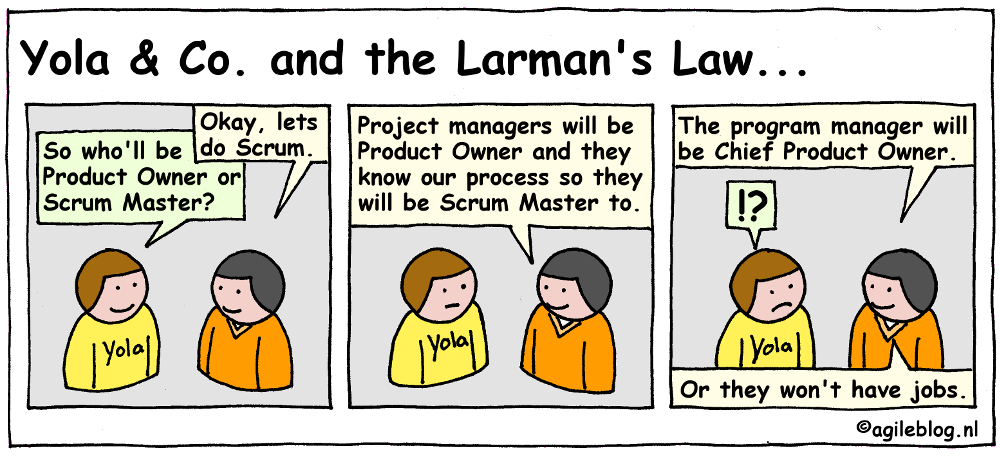on
Yola & Co. and Larman’s Law…

As said in my previous post, we need to change the way we deal with teams. Especially with precious high performing teams. Therefore servant leadership is very necessary for an Agile implementation to be successful.
In order to become a servant leader as manager, one has to change behaviour. As an Agile coach it is not hard to convince the employees that change is needed and that this change involves a behavioural change as well. The same is true for convincing higher management. Nine out of ten times they do understand the need to change and the nature of those changes to become and/or remain a responsive enterprise in an ever changing market.
So where is the pain? A part of the problem is the middle management (or the clay layer, “kleilaag” as we like to refer to in Dutch) that prevents the change to take place. I’ve seen CEO’s fail to get the message through, even with help from the working force sending the same message bottom up, the middle management was still impenetrable. Just like water can’t penetrate a clay layer (that’s why we call it kleilaag :))
I have to admit that I’ve been accused many times for being “to strict”, “to fundamentalistic” or “not pragmatic enough” for companies to be of any help for them or so they thought. Many times I saw those same companies try to implement Agile and Scrum while keeping the standing organisation intact. Scrum would be mutated until it would fit the status quo. Only once I have witnessed a company removing the middle management layers (lets say L4 up to L2) so the change could take place. At this company it did pay of to be a fundamentalist2 by the way.
Later on in my career as Agile coach I had a talk with one of the managers about his software delivery center. I started talking about how I would run his delivery center and after a while he asked where the project and delivery managers where. I told him I would come to that later. So after a while he asked me again where the project and delivery managers went. Again I told him I would come to that later. While I continued explaining my vision he suddenly said “…but we don’t need project managers and we can do with less delivery managers so the rest of them can earn their money as consultants in the field!” Shortly after this event I was positioned into the consulting market as an Agile Fundamentalist (a.k.a. Agile Consultant) by my managers.
I can’t help thinking back on these events, accusations, discussions and naming with a big smile on my face when I found this article of Craig Larman….I think I see a pattern 😉
Larman’s Laws of Organizational Behavior
After decades of observation and organizational consulting, here are Larman’s Laws of Organizational Behavior. These are observations rather than laws to follow 😉
1. Organizations are implicitly optimized to avoid changing the status quo middle- and first-level manager and “specialist” positions & power structures.
2. As a corollary to (1), any change initiative will be reduced to redefining or overloading the new terminology to mean basically the same as status quo.
3. As a corollary to (1), any change initiative will be derided as “purist”, “theoretical”, “revolutionary”, “religion”, and “needing pragmatic customization for local concerns” — which deflects from addressing weaknesses and manager/specialist status quo.
4. Culture follows structure.
Or, Culture/behavior/mindset follows system & organizational design. i.e., If you want to really change culture, you have to start with changing structure, because culture does not really change otherwise.
And that’s why deep systems of thought such as organizational learning are not very sticky or impactful by themselves, and why systems such as Scrum (that have a strong focus on structural change at the start) tend to more quickly impact culture — if the structural change implications of Scrum are actually realized.
I discovered that the well-known systems-thinker/advocate John Seddon also observed this: “Attempting to change an organization’s culture is a folly, it always fails. Peoples’ behavior (the culture) is a product of the system; when you change the system peoples’ behavior changes.”
Courtesy of Craig Larman